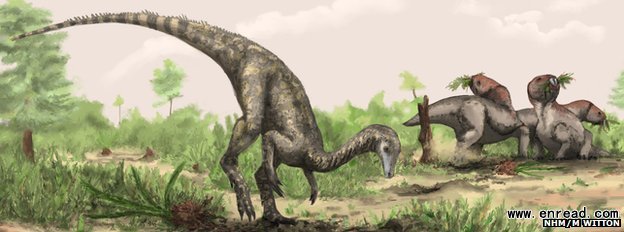| ||||||||||||||||||||||||||||||||||||||||||||||||||||||||||||||||||||||||||||||||||||||||||||||||||||||||
|
Palaeontologists have found what is likely to be the oldest known dinosaur1, filling in a yawning evolutionary2 gap.
古生物学家发现了一种可能是最古老的已知恐龙品种,填补了进化史上的巨大空白。
 dinosaurs3' closest relatives" style="cursor:pointer" onclick="window.open('/upimg/allimg/121205/1_121205083522_1.jpg')" /> dinosaurs3' closest relatives" style="cursor:pointer" onclick="window.open('/upimg/allimg/121205/1_121205083522_1.jpg')" />Nyasasaurus parringtoni would have shared the land with silesaurs, identified as dinosaurs' closest relatives A study in Biology Letters describes Nyasasaurus parringtoni, a new species from 10-15 million years before the previous earliest dinosaur specimens4.
It walked on two legs, measured 2-3m in length with a large tail and weighed between 20 and 60kg.
The find suggests that many millions of years passed between dinosaurs' first members and their dominance on land.
"It fills a gap between what we previously5 knew to be the oldest dinosaurs and their other closest relatives," report co-author Paul Barrett, of the Natural History Museum in London, told BBC News.
"There was this big gap in the fossil record where dinosaurs should've been present and this fossil neatly6 fills that gap."
However, the team behind the work has stopped short of definitively7 calling N parringtoni the earliest dinosaur, because the fossil skeletons used to define it were incomplete: one upper arm bone and six vertebrae.
The early evolution of dinosaurs is difficult to unpick, as a rich variety of reptiles8 were proliferating9 at the time - and some may even have independently evolved characteristics that are associated with dinosaurs.
But the researchers, from the University of Washington and University of California Berkeley in the US and the Natural History Museum, saw a few features that are unambiguously(不含糊地) those of dinosaurs, notably10 what is called an "elongated11 deltopectoral crest12" that served as an anchor for strong pectoral muscles(胸肌).
Lead author of the research Sterling13 Nesbitt, of the University of Washington Seattle, led a team that in 2010 reported the finding of dinosaurs' oldest relative, a member of a group called the silesaurs.
It now appears that those creatures shared the southern part of the supercontinent Pangaea - now South America, Africa, Antarctica and Australia - with N parringtoni.
"Those animals were the earliest of this group that led up toward dinosaurs," explained Dr Barrett. "Now this takes dinosaurs back to the right kind of time when those two groups would have split apart from each other."
点击  收听单词发音 收听单词发音
|
||||||||||||||||||||||||||||||||||||||||||||||||||||||||||||||||||||||||||||||||||||||||||||||||||||||||
上一篇:2013世界最佳出生地:瑞士 下一篇:谷歌出资赞助濒危物种保护 |
||||||||||||||||||||||||||||||||||||||||||||||||||||||||||||||||||||||||||||||||||||||||||||||||||||||||
- 发表评论
-
- 最新评论 进入详细评论页>>



